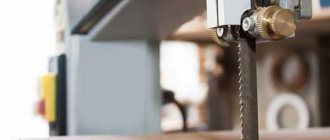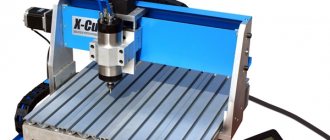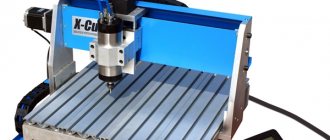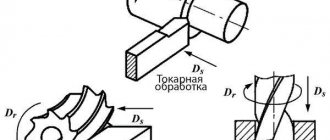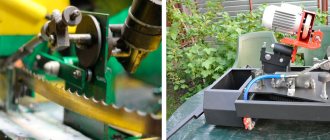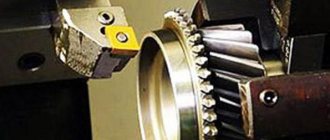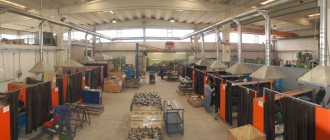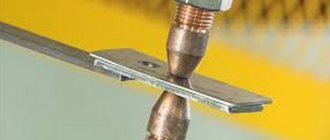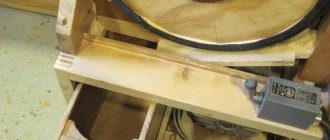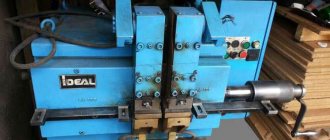Machine
The initial inspection of the equipment is carried out on the following components:
• Machine pulleys – should not have signs of wear on cylindrical surfaces and flanges; bearing play is eliminated; the working cylindrical surfaces must be parallel to each other. There should be a gap between the flange and the canvas. • Guides – must not be worn out or misaligned; must have lead-in chamfers to prevent scuffing on the blade. The canvas should move freely in the guides. • Hydraulic supply system – must not have leaks; The oil level must meet the established standards.
Inspection of used blades in waste will help to establish in advance the possible natural cause of failure of band saws.
According to the material from which band saws are made.
- Tool steel blades
. Manufactured from a single strip of high quality alloyed and hardened carbon tool steel. Teeth hardened to 65-67 HRC and a flexible base allow them to be used for sawing simple materials: unalloyed steels with low tensile strength, for cutting composite materials, for friction sawing on special machines. They are most suitable for use in repair shops on the simplest stationary and manual machines with small diameter pulleys. - Bimetallic sheets
. The base is made of elastic spring steel (analogous to 45KhGNMFA). A high-speed steel (HSS) profile wire is welded to the base using electron beam welding, after which the tooth profile is milled and hardened to a hardness of 66-70 HRC. Such blades are highly resistant to wear and heat, which allows them to be used when working with almost all metals and alloys.
Based on the grade of HSS steel used, bimetallic sheets are divided into three types:
- M42
steel is a steel with a high content of tungsten, molybdenum and cobalt. Has excellent abrasion resistance and high red fastness. Designed for cutting structural steels, alloyed tool and die steels, cast irons, corrosion-resistant steels, for cutting non-ferrous metals and any other steels with a hardness of up to 45 HRC. - M51
steel is a steel with a higher content of molybdenum and cobalt. Has excellent abrasion resistance and high red fastness. Used when working on viscous and complex materials. Designed for cutting structural steels, alloyed tool and die steels, cast irons, corrosion-resistant steels, for cutting non-ferrous metals and any other steels with a hardness of up to 45 HRC. The durability of such a blade is, as a rule, 10-20% higher than that of saws with a cutting edge material made of M42. - Improved steels, for example X3000 from WIKUS
. It was produced from high-quality high-speed steel using powder metallurgy. The reliability of the tool has been increased due to the reduction in the likelihood of formation of defects during cutting, such as burns, chips and microcracks. Compared with M51, the tool life has increased to 25%.
- Brazed carbide blades
. They are made of high-alloy steel, and carbide plates are applied to the teeth by soldering. This tool is recommended for high-performance sawing of exotic, super-hard, hardened, heat-resistant and stainless steels and alloys, titanium, nickel, etc. - Carbide-coated blades
. They are made from high-alloy steel by spraying carbide chips from tungsten carbide with a cobalt binder. A distinctive feature of the blades is the absence of teeth, and the cutting edge is continuous or segmented. This tool is recommended for high-performance sawing of hardened and non-uniform steels, as well as composite materials, abrasive building materials, glass, electrical cables, reinforced rubber, and stone. A distinctive feature is the ability to cut different materials with one blade. - Diamond coated blades
. They are similar to toothless carbide blades, but the cutting element is the most durable material in the world - diamond, capable of sawing any material, including any metal, because it is multiple times higher than carbide in hardness.
Selection of cutting fluid STF Slavyansky Dvor
Numerous experiments conducted by American researchers led them to the conclusion that there is no need to use lubricant at all until the sawdust begins to be used on the saw. In this case, the optimal lubricant should be used: a mixture of 50% diesel fuel and 50% oil for lubricating chainsaw tires. This mixture should be sprayed evenly on both sides of the canvas. Automotive windshield washer systems have proven themselves to be excellent for this purpose. There shouldn't be a lot of lubrication. You will easily notice that it is time to lubricate by the sound that disappears after applying the lubricant. The use of such a lubricant will allow you to reduce the number of boards and extend the life of the belts on the drive pulley, since they will no longer be exposed to sawdust, water or snow.
Release the saw tension as soon as you stop sawing.
During the sawing process, the blade heats up and, therefore, stretches and increases in length. As they cool down, the saws tend to shrink back to their original size. This is where excess stress appears, which can later cause the formation of cracks. If you leave the saw blade under tension, you place unnecessary stress on the supports and rods, which can disrupt the geometry of the drive pulleys and shorten the life of your frame.
The blade is also shaped like both pulleys, which does not extend the life of the saw. Add to this the inevitable deformation of the belts on the pulleys, which leads to additional vibration of the belt. Therefore, even during short stops, especially in the cold season, loosen the tension of the belts.
According to the type of tooth shape and sharpening angle.
Each manufacturer has many series of blades made from the same material, but intended for cutting different types of metal. The main difference between such blades is the shape of the tooth, the main varieties of which are discussed below:
- Shape S or Standard.
The rake angle of the tooth is 0 degrees. Ideal for short chipping materials, high carbon steels, cast iron, small workpieces, thin-walled profiles, brittle materials. - shape or Hook.
The front angle of the tooth is 10 degrees, positive. This is a form for universal use, i.e. If you don’t know which one, take this one. Typically used for non-ferrous metals and steels with a carbon content <0.8%, structural steels, tempered steels, large profiles, solid sections, non-ferrous metals and steels. - Shape L or Long.
The rake angle of the tooth is 0 degrees. Increased interdental space. Ideal for sawing soft materials (aluminum and wood). - Form M or Variable.
The front angle of the tooth is 10 degrees, positive. Tooth height is variable. Optimally suited for sawing stainless steels, high-performance cutting of viscous materials, and large-section workpieces. - Form P or Profile.
The front angle of the tooth is 5 degrees, positive. Ideal for hollow profiles and angles, steel beams, sawing packages of workpieces, because reduces the level of vibration when sawing. - R or shape .
The rake angle of the tooth is 16 degrees, positive. Optimally suited for stainless steels, high-performance cutting of viscous materials, and large-section workpieces. Has a long service life. - shape or Trapezoidal.
Provides high productivity and the best cutting quality. Let's list the main ones.
- TSN.
Negative rake angle combined with increased inter-tooth gullet for superior chip evacuation. Suitable for: hardened steel with a hardness up to 68 HRC, workpieces with a hardened surface (shafts), hard workpieces no more than 275 mm, chrome-plated surfaces, chrome. - TSN ENR.
Super-negative rake angle combined with increased inter-tooth gullet for superior chip evacuation. Suitable for: hardened steel with a hardness up to 68 HRC, workpieces with a hardened surface (shafts), hard workpieces no more than 275 mm, chrome-plated surfaces, chrome. - TNF- A.
Positive rake angle combined with an enlarged gullet for superior chip evacuation. Suitable for: non-ferrous metals and aluminum alloys. Optimally used on machines with low vibration levels and manual feed. - TNF- B.
Positive rake angle combined with a larger inter-tooth cavity for superior chip evacuation. Suitable for: non-ferrous metals and aluminum alloys. Ideal for use on machines with high feed speeds. - There are many more varieties of this type, because Each manufacturer has in its assortment a wide variety of blades with specific tooth shapes to solve highly specialized problems.
Band saw blade feed speed
Each tooth of the band saw blade must cut metal shavings of a given thickness. With this approach, you can achieve optimal cut quality. The selection of the blade feed speed is carried out depending on the recommendations of the equipment manufacturers, as well as taking into account the type of chips that will be obtained during cutting. When the chips are thin or even dusty, it is recommended to increase the blade feed speed or reduce a parameter such as cutting speed. If the chips curl weakly, then the sawing mode has been selected accurately and correctly. Thick chips indicate that the saw blade feed speed is too high.
According to the pitch of the tooth from which band saws are made.
Tooth pitch is indicated either in TPI (Teeth Per Inch), where the pitch is determined by the number of teeth per inch of the blade, or in millimeters, where the pitch is determined by the distance between the teeth.
There are two types of tooth pitch:
- The constant pitch
is designed for cutting solid workpieces. - A variable pitch
is needed when cutting variable sections of pipes and profiles. Variable tooth pitch reduces excessive blade stress and significantly reduces noise and vibration levels.
RULE!
A minimum of 3 teeth must be along the length of the cut. If there are too few teeth along the length of the cut, the tooth can become stuck and break. A maximum of 24 teeth must be in the length of the cut. Too many teeth lead to overheating and shorten the life of the saw, because The cavities between the teeth do not accommodate chips. This leads to the band saw being pressed away from the cutting surface, its rapid wear or breakage: the tooth cuts chips that fill the tooth cavity; when the cavity is filled, cutting resistance increases; If the feed is not reduced, cutting becomes intermittent and the teeth of the band saw break. Soft materials require sparser band saw teeth and larger gullet volume (Min 3, Opt 6-12, Max 24). Hard materials require more teeth working simultaneously and less cavity volume (Min 6, Opt 12-24, Max 48). You should also take into account whether a single workpiece will be cut or whether it will be a batch cutting.
- For example, with a pitch of 5/8 TPI or 3.9 mm, there are 26 teeth simultaneously on a 100 mm long workpiece.
The capabilities of the band saw also influence the choice of band saw tooth pitch. On band saws equipped with constant feed mechanisms, you can use band saws with larger pitches, which will allow you to work with greater productivity. Weight-fed band saws require smaller pitch band saws.
Cutting modes
Selecting cutting speed
It must be remembered that during the sawing process the band saw heats up. The higher the speed of the saw during sawing, the higher the heating temperature.
The choice of cutting speed therefore depends on the type of band saw, the size of the material and the density of the material.
The shape of the chip will help you select the correct frame speed during the cutting process:
Too high a frame (feed) speed when cutting causes the machine to “shudder” and increase noise levels.Excessive feed can lead to shearing of teeth or tearing of the blade.
Insufficient feed leads to strain hardening of the workpiece and dulling of the blade. Control the feed according to the chip shape.
Excessive saw speed increases heat production and dulling or shearing of blade teeth, especially on carbon steel blades. See recommendations for cutting modes for various materials.
The best manufacturers
Among the companies producing band saws, experts recommend the following, which occupy the first lines of the rating:
- Arntz. A German company, in whose production facilities constant monitoring of the quality of products is carried out, and research is also being carried out in order to modernize technologies and improve the characteristics of band saws.
- Lenox. An American company, a special feature of this manufacturer is a specially developed coating, it is called Armor. Thanks to it, the products have increased strength and resistance to physical wear.
- Wikus. Another manufacturer from Germany, which has been at the top of the list of the best manufacturers of band saws for a long period of time. The advantages of the company include many years of experience in the production of tools and a large list of available models.
- Forezienne is a French company for the production and maintenance of cutting tools. Its main feature is the production of blades for band saws from steel, which is made from high-grade rocks and is processed by a hardening and tempering system.
- Lennartz is an equally large manufacturer of blades for tape machines, in demand in Europe. This company specializes in the manufacture of saws based on composite alloys.
- Doall is an American manufacturer, known in the market for its high quality band saws.
All products are reliable and have a long service life.
What is this?
A band saw blade for metal is a flexible, ring-shaped cutting blade that can have different types of teeth. They play a key role in the selection of this element of the band saw machine. The blade is used for cutting in metalworking. At the same time, it is used on both household and industrial equipment.
What do you need to know?
The band saw blade differs in such criteria as the material from which it is made, the shape of the teeth, and the setting option. The tape itself is made of monolithic high-carbon steel or a bimetallic alloy. Steel products, characterized by a tensile strength of up to 80 MPa, are used for cutting non-ferrous metals, steel and cast iron blanks. Such canvases are used on console and single-column units for professional and semi-professional purposes.

